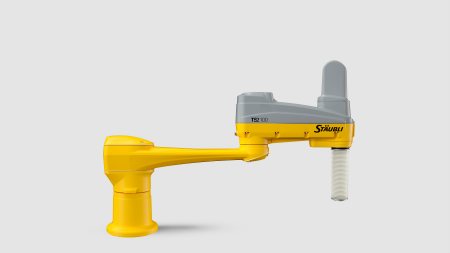- Europe
- Americas
- Asia and Middle East
- Africa and Oceania
SUCCESS STORY
Artificial intelligence replaces time-consuming teaching
A robot-assisted unloading cell from Hans Weber Maschinenfabrik shows just how simple the automation of machine unloading can be. Thanks to artificial intelligence, the time-consuming teaching and learning of part variants is completely eliminated.
CUSTOMER BENEFITS
- Very simple AI solution
- Teach-free process for users without robotics experience
- Innovative unloading system also for mobile applications
- Highly dynamic robot with integrated tool changer
TASK
AI-supported automation of machine tools
Automated unloading of processing machines is standard today. Hans Weber Maschinenfabrik takes it a decisive step further: In an unloading system, a Stäubli SCARA robot stacks any part without prior learning. AI makes this possible.
In hardly any application is the benefit of artificially intelligent systems more evident than in fully automated machine unloading. At first glance, you can’t tell what Weber’s AI unloading system is made of: a high-performance Stäubli TS2-100 SCARA with a 1,000-mm reach and automatic tool changer, a high-end optical recognition system with AI software, and a robust conveyor system – and the compact masterpiece is complete.
SOLUTION
High-precision camera systems and AI enable seamless integration
It is impressive how the large Stäubli TS2-100 SCARA works in the compact Hans Weber HS-4-1000 unloading system: New parts whose geometry is not stored in the system reach the cell from the processing system’s conveyor belt and instead of the expected shutdown, something surprising happens. The robot picks up a part that it has not learned and places it on a Euro pallet. Just like that – without any human intervention.
And this is how it works: High-precision camera systems with AI-supported software capture and localize each part during operation at a continuous belt speed of up to 10 m/min. The system determines the optimum gripping point for each part depending on its center of gravity, transmits the data to the robot controller, and saves each new variant in the higher-level PLC. This method enables seamless integration into the production process and eliminates the need for manual intervention, ensuring efficient and reliable operation of the production line.
- Teaser
- Teaser
- Teaser
CUSTOMER USAGE
Intelligent automation without prior robotics knowledge
With this pioneering unloading cell, users without any robotics experience can reap the benefits of automating their machine tools. The key lies in the setup-free process, which does not require time-consuming programming.
The TS2-100 SCARA has a reach of 1,000 mm and a long stroke in the Z-axis, allowing it to move to all positions for stacking on a Euro pallet. The robot is also highly dynamic, precise and reliable and has an integrated tool changer. Attributes like these make the Stäubli TS2-100 the perfect choice.
Another major advantage of this robot for AI applications is the openness of the Stäubli CS9 controller, which offers Weber programmers a range of options and can be used to easily connect all standard image processing systems.
The complete compact HS-4-1000 unloading system weighs only around 2.5 tons and can therefore be moved with a forklift, allowing some mobility. This gives users the option of docking the cell to different processing machines as needed.

